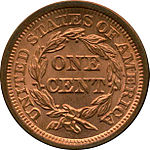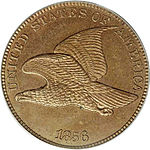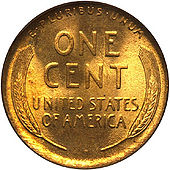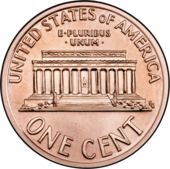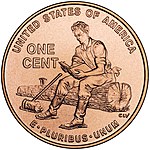1 cent coin (United States)
The one cent coin is the smallest coin in circulation in the United States . They are worth one hundredth of a US dollar . Colloquially, the coin is usually referred to as a penny .
The portrait of Abraham Lincoln , the 16th US President , has been depicted on the front since 1909 . Between 1959 and 2008 the Lincoln Memorial was on the back . In 2009, four special motifs were struck in honor of Lincoln, and a coat of arms has been on the back since 2010.
Large cents
The cents minted from copper between 1793 and 1857 with a diameter of 27 to 29 mm are called "large cents". They show a portrait of Liberty on the front and the wreathed value on the back. According to the different design of the portrait, the following types are distinguished:
- Flowing Hair Cent (1793, part of which has a chain instead of a wreath on the back, "Chain Cent")
- Liberty Cap Cent (1793–1796)
- Draped Bust Cent (1796-1807)
- Classic Head Cent (1808-1814)
- Coronet Cent (1816–1839)
- Braided Hair Cent (1840-1857)
Flying Eagle Cent
The “Flying Eagle Cent” was minted from 1856 to 1858 (although only a small sample was produced in 1856 ). It is the first "Small Cent" with a diameter reduced to 19 mm. The design is by James B. Longacre and shows an eagle in flight on the front and the value indicated by a wreath on the back.
The coin weighs 4.67 g and is made of a copper-nickel alloy with 88% copper and 12% nickel . It was given the nickname "Nickel", a designation that was later transferred to the 5-cent piece , which was made of copper-nickel from 1866 onwards .
It turned out that the design in the hard coin metal was difficult to mint. The head and tail of the eagle faced the wreath and were therefore often not fully developed. A new design was soon sought.
Indian Head Cent
The "Indian Head Cent" was minted from 1859 to 1909. Like the previous motif, it was designed by James B. Longacre. The obverse shows a portrait of Liberty with an Indian headdress. The reverse shows the indication of value surrounded by a wreath. The design of the wreath was changed in 1860, and a coat of arms was added at the top.
From 1859 to 1864 the coin, like the Flying Eagle Cent, was minted from copper nickel. In 1864 they switched to bronze (95% copper , 5% tin and zinc ) and the weight was reduced to 3.11 g.
Lincoln Cent
The "Lincoln Cent" was introduced in 1909, on the hundredth birthday of Abraham Lincoln . The front, designed by Victor David Brenner, which is still in use today, shows the portrait of Lincoln. It is the first portrait on a US coin that no longer depicts Liberty, but a historical figure.
The back design was changed in 1959 and then again in 2009/10. A copper alloy was used as the material until mid-1982 (except in the war year 1943, when galvanized steel was used), since then the coin has consisted of a zinc core coated with copper.
Wheat cents
The type, minted from 1909 to 1958, shows the value and the country name on the reverse, framed by two ears of wheat. Above it stands the national motto E pluribus unum .
Like the front, the design is by Victor David Brenner. The original design had Brenner's name at the bottom. It was abbreviated to “VDB” when it was first struck. But that also provoked criticism because it emphasized the designer too much. Therefore, the initials were left out that same year. From 1918 they reappear in a smaller form on the front, on the lower left edge of Lincoln's bust.
Lincoln Memorial Cent
In 1959, for Lincoln's 150th birthday, a new back design was introduced. The design comes from Frank Gasparro and shows the Lincoln Memorial with the country and value designation and the motto "E Pluribus Unum". The designer's initials, "FG", can be seen to the right of the building. This back was in use until 2008.
Commemorative coins for the 200th birthday of Lincoln
The law on the issue of the presidential dollars ( Presidential $ 1 Coin Act of 2005 ) stipulated, among other things, that for the 200th birthday of Lincoln in 2009, four new motifs should appear on the 1-cent coins, honoring the life of Lincoln.
The four motifs are:
- Birth and early childhood in Kentucky . It shows the log cabin in which Lincoln was born and his year of birth 1809. The motif was designed by Richard Masters and engraved by Jim Licaretz. The coin went into circulation on Lincoln's 200th birthday on February 12th.
- Years of Development in Indiana . This motif shows the young Lincoln reading, taking a break and reading while splitting wood. It was designed and engraved by Charles Vickers.
- Working life in Illinois . Here Lincoln is seen in front of the Illinois State Capitol in Springfield . The motif was designed by Joel Iskowitz and engraved by Don Everhart.
- Presidency in Washington, DC This motif shows the cathedral of the Capitol under construction. The design is by Susan Gamble and the engraving by Joseph Menna.
Like the previous editions, the coins intended for circulation were made with a zinc core. In addition, a special edition for collectors was minted, which has the same composition as the cents from 1909 (95% copper, 5% tin and zinc).
Union Shield Cent
In addition to the special motifs from 2009, the Presidential $ 1 Coin Act of 2005 also envisaged a redesign of the 1-cent coin from 2010. The law stipulated that the reverse motif should be emblematic of Lincoln's preservation of the United States as a united nation.
A heraldic shield with 13 stripes ( symbolizing the 13 founding states of the USA ) and the motto “E Pluribus Unum” was chosen as the motif , with the value being written on a scroll above.
composition
The first issues of the Lincoln Cent were initially produced in the same composition as the Indian Head Cent, namely with 95% copper and 5% tin and zinc . Because copper, which was used for military purposes, became scarce during World War II , the 1-cent coins were made from galvanized steel in 1943 . The weight was reduced to 2.7 g with this composition. The edges of the coin remained ungalvanised, so that the coin was susceptible to rust. In addition, with its gray color, it was difficult to distinguish from the dime . In 1944 a different composition was therefore used again. The alloy obtained from old cartridge cases was similar to the one made before the war, but with less tin. After 1946 they returned to the old composition. From 1962 the tin component was completely omitted; however, the copper content of 95% remained the same.
In the 1970s, the price of copper soared that the metal value of the coin almost exceeded its face value. In 1973 pieces of aluminum were minted (although dated 1974), but they were never issued. Very few pieces are in the possession of collectors.
In mid-1982, the production of the coin from zinc, which is coated with copper, began. The weight proportions are 97.5% zinc and 2.5% copper. Since then the coin weighs only 2.5 instead of 3.11 g. The diameter of 19.05 mm and the thickness of 1.55 mm remained the same.
According to the US Mint , the production of a 1 cent coin cost 1.67 cents in 2007, in 2011 the cost was 2.41 cents, in 2013 it was 1.87 cents. Proposals to change the composition again or to abolish the coin entirely have been made repeatedly, but have not yet been implemented.
See also
Individual evidence
- ↑ a b Presidential $ 1 Coin Act of 2005
- ↑ United States Mint Annual Report (PDF; 4.1 MB)
- ↑ Production costs of the 1 cent coin in recent years (English)
- ↑ CNN Money: Should the penny go?



